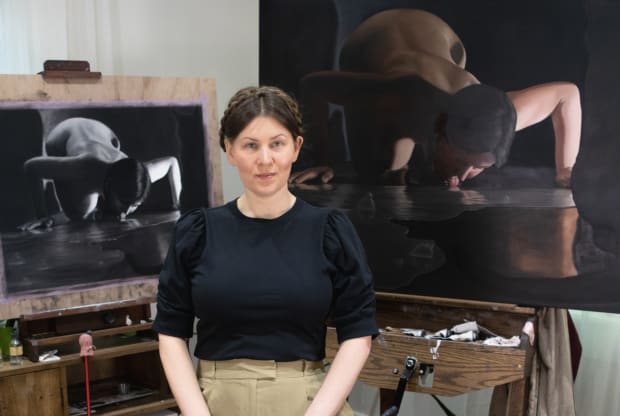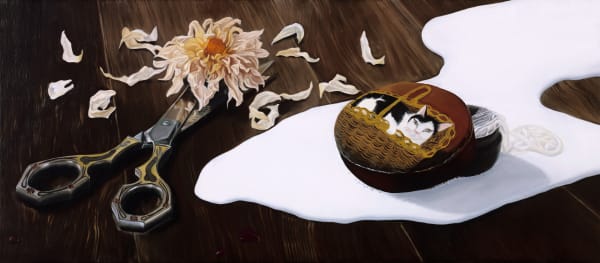-
When Dusk Falls
Jamie Luoto - Tonia Nneji -
Jamie Luoto
 Highlights and CollectionsJamie Luoto’s painting We Hunt the Doe was a semifinalist for the Smithsonian Institute’s Outwin Boochever Portrait Competition, 2022. Her work has been featured in publications such as Booooooom.com, ArtMaze Mag, and New American Paintings; appeared on platforms such as Juxtapoz and Hyperallergic. Luoto's work can be found in private and public collections globally including Green Family Art Foundation (Dallas, USA) and Il Castello (Nocciano, Italy).
Highlights and CollectionsJamie Luoto’s painting We Hunt the Doe was a semifinalist for the Smithsonian Institute’s Outwin Boochever Portrait Competition, 2022. Her work has been featured in publications such as Booooooom.com, ArtMaze Mag, and New American Paintings; appeared on platforms such as Juxtapoz and Hyperallergic. Luoto's work can be found in private and public collections globally including Green Family Art Foundation (Dallas, USA) and Il Castello (Nocciano, Italy). -
Tonia Nneji
 Highlights and CollectionsTonia Nneji’s work has been featured and can be found in publications of Forbes Africa, 30 under 30, Class of 2022; New York Times: From Lagos to Los Angeles, An African art Gallery arrives (February 17, 2021); Vogue, in the art of Tonia Nneji and Zohra Opoku, poignant narratives of healing, (13 November 2020); ‘The New Guard’, South African Art Fair relaunches as FNB art joburg, Harper’s Bazaar; Harper’s bazaar US: The New Guard. In Celebration of Black History Month; Article written by Chimamanda Ngozi Adichie (February 2020); Nation Newspaper, ALERTS! Female visual artists on the rise, The Vanguard (2017); The Guardian newspaper: Nneji,The Fluidman and his peers, (October 8th, 2017); BBC Africa, International Women’s Day by Chimamanda Adichie. woman.ng : Anthonia Nneji Art speaks about struggles, she is not doing Art for Art sake, but also for life sake; Residency, Art Dubai Residency (2019); Recipient of the Ronke Ekwensi Fellowship, New Jersey (2018).
Highlights and CollectionsTonia Nneji’s work has been featured and can be found in publications of Forbes Africa, 30 under 30, Class of 2022; New York Times: From Lagos to Los Angeles, An African art Gallery arrives (February 17, 2021); Vogue, in the art of Tonia Nneji and Zohra Opoku, poignant narratives of healing, (13 November 2020); ‘The New Guard’, South African Art Fair relaunches as FNB art joburg, Harper’s Bazaar; Harper’s bazaar US: The New Guard. In Celebration of Black History Month; Article written by Chimamanda Ngozi Adichie (February 2020); Nation Newspaper, ALERTS! Female visual artists on the rise, The Vanguard (2017); The Guardian newspaper: Nneji,The Fluidman and his peers, (October 8th, 2017); BBC Africa, International Women’s Day by Chimamanda Adichie. woman.ng : Anthonia Nneji Art speaks about struggles, she is not doing Art for Art sake, but also for life sake; Residency, Art Dubai Residency (2019); Recipient of the Ronke Ekwensi Fellowship, New Jersey (2018). -
When Dusk Falls

-
The transference of imagery between different paintings adds to the feeling of claustrophobia, which is at its most heightened in The Black Fell Open – the largest and perhaps most complex work in the show. Once again there is a naked figure on all fours, this time facing away from us with a black cat winding between her thighs. The cat is simultaneously exposing itself while shielding the figure. It appears to go in through her legs to seemingly emerge as another figure, crouched and wearing a paper bag over its head. This, Luoto, explains is ‘the dissociated self.’ Above them, dead birds hang upside down from strings and scattered across the sheet are red apples being nibbled by mice. Are we encountering the aftermath of a ritual? Some kind of nest? A fairy-tale or a nightmare? As with all of Luoto’s compositions, the imagery is loaded with multiple potential meanings, allowing the viewer to find their own points of connection.Nigerian artist Tonia Nneji similarly uses symbolism to confront a culture of suppression and violence against women, particularly in relation to the influence of religion. In 2014 she was diagnosed with polycystic ovary syndrome but rather than being offered medical assistance, she was encouraged by family members to attend church programs. ‘It was their understanding of life and I never faulted them for it,’ she says, ‘but sadly in Nigeria and most of west Africa religion comes before medicine.’ As a result, Nneji, as well as many other women, ended up feeling powerless over her own body, a feeling which is reflected in the dark, cavernous backgrounds in which her figures appear.At the same time, her figures command and reclaim these spaces. They are clothed in bright, patterned fabrics and gaze directly at the viewer. In one work, a woman sits at the top of a corridor of intricate arches that evokes the imposing grandeur of church architecture. Her pose is one of defiance and indifference – she is barefoot, her dress falling off her shoulders and down between her open legs. Elsewhere, resistance is more subtly conveyed. For instance, in another painting set in a similar type of space, a figure stands wearing a dress that is emblazoned with logos depicting the (male) reverend and various saints. ‘We live in a society where people who pledge allegiance to a thing always want to show off that they belong to that group,’ says Nneji. ‘It’s common to go to a particular church and see people wearing customised prints made by that church.’ In Nneji’s work, this kind of fabric becomes a symbol of ownership and entrapment rather than belonging, but it is one that her figures rebel against through their own embellishments such as a flash of red fabric tied around the waist or clasped in a hand.Importantly, in the work of both artists, the female body itself is also a site not just of violence but of resistance. They empower the female body by making visible the unseen and the repressed, by sharing their trauma and vulnerability but by also confronting the viewer and eliciting discomfort. These are paintings that challenge us to not look away.
-
When Dusk Falls: Jamie Luoto & Tonia Nneji
Past viewing_room
















